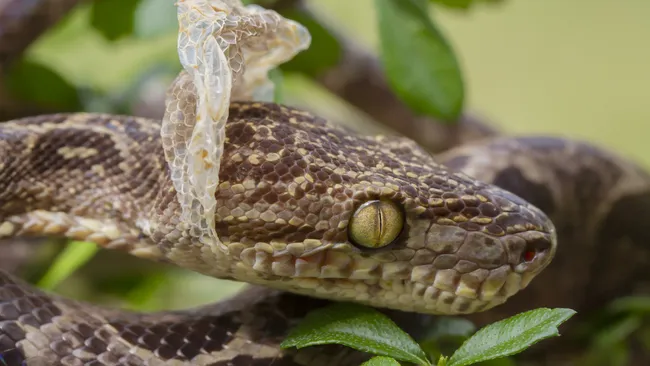It’s a story that involves scales, sloughs — and spectacles.
Snakes are some of the few creatures capable of shedding their skin, a process known as “ecdysis.” Throughout their life, a snake will slough off its old skin, leaving behind delicate sheddings marked by the distinct pattern of its scales.
Although shedding skin isn’t unusual, the way snakes do it is different from us. “Unlike humans, whose skin sheds in small flakes, snakes create a whole new layer of skin and shed the old one in a single, complete removal,” explains Jason Dallas, a postdoctoral researcher at Middle Tennessee State University who studies bacterial-fungal interactions in reptiles.
So, why do snakes shed their skin, and why is it done all at once?
Snake skin consists of two main layers: the inner dermis, which contains the pigments responsible for their colors and patterns, and the outer epidermis, a tougher layer of semi-transparent keratin scales. While human skin also contains keratin, our skin flakes off in small, almost invisible pieces, whereas a snake’s outer layer forms a continuous sheath. This covering is rigid and unable to expand, restricting the snake’s growth. As a result, snakes shed their skin to allow for more room as they grow. Young snakes shed more frequently because they grow faster.
In fact, the first shedding occurs shortly after birth or hatching. By adulthood, snakes usually shed around three to four times per year, says Daniel Kane, senior reptile keeper at the London Zoo.
When a snake is ready to shed, a fresh keratin layer forms beneath the old one, and the snake secretes fluids to loosen the old skin. The snake then finds a rough surface to rub against, creating a slit through which it begins to slough off the old skin. With continued rubbing and muscle movement, the snake eventually sheds its skin, revealing a shiny new set of scales. In fact, the new skin may be 20% longer than the original before it dries and becomes rigid.
After the skin is discarded, the snake moves on, although it rarely eats its old skin. Some reptiles, like geckos, do consume their sheds to regain lost nutrients.
Shedding also aligns with key life events such as the snake’s emergence from hibernation or the reproductive period. “They typically shed before laying eggs or giving birth, and may shed again after,” Dallas explains. Shedding also helps snakes get rid of parasites, like the fungus that threatens their health.
However, shedding is not without its drawbacks. It’s an energy-intensive process, and during this time, a snake’s vision may be clouded by secretions, making it vulnerable to predators. Additionally, increased shedding due to disease can impact the snake’s survival chances, especially in species like the eastern massasauga rattlesnake.
Despite the challenges, shedding remains essential for the snake’s growth and health. It can even be useful for conservation efforts, as discarded skins can reveal genetic information and help track populations.
Interestingly, while most reptiles shed their skin in pieces, some, like the lizards from the Abronia genus, leave behind complete skins, including their legs.
